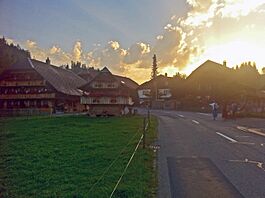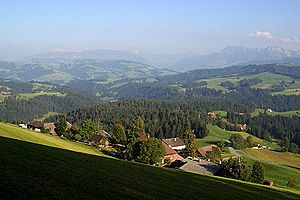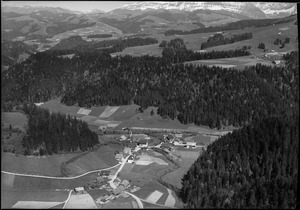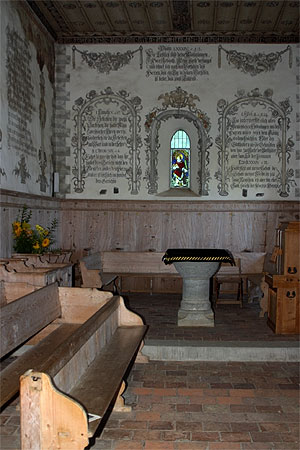Röthenbach im Emmental facts for kids
Quick facts for kids
Röthenbach im Emmental
|
||
|---|---|---|

Röthenbach im Emmental village
|
||
|
||
| Country | Switzerland | |
| Canton | Bern | |
| District | Emmental | |
| Area | ||
| • Total | 36.8 km2 (14.2 sq mi) | |
| Elevation | 824 m (2,703 ft) | |
| Population
(Dec 2020 )
|
||
| • Total | 1,169 | |
| • Density | 31.77/km2 (82.27/sq mi) | |
| Postal code |
3538
|
|
| Localities | Dorf, Gauchern, Oberei | |
| Surrounded by | Bowil, Buchholterberg, Eggiwil, Eriz, Linden, Oberlangenegg, Schangnau, Signau, Wachseldorn | |
Röthenbach im Emmental is a small town, also called a municipality, in Switzerland. It is located in the Emmental area, which is part of the canton of Bern.
Contents
A Look Back in Time
Röthenbach was first mentioned in old records in 1148. It was called Rochembac back then.
The town likely grew around a special religious building called a priory. This priory was built before 1148. It was connected to another priory in Rüeggisberg and was led by a prior. By the late Middle Ages, a village had formed near the priory. There was also a parish church (a church for the local community) at Würzbrunnen. The prior was like a landlord and judge for the villagers.
In 1399, the city of Bern bought the area of Signau, which included parts of Röthenbach. The priory still had some control over a few settlements. However, Bern's local leader, called a vogt, judged other villagers. Over time, the Rüeggisberg Priory became less important. In 1484, both priories became part of a new religious college in Bern Minster.
In 1494, both the priory church and the parish church were damaged by a fire. They were quickly rebuilt. In 1528, Bern changed its main religion to Protestantism. This meant that monasteries, including Röthenbach Priory, were no longer controlled by the church. The priory's land eventually became part of the new town of Röthenbach. The priory church was taken down between 1540 and 1558, but it was rebuilt in 1905.
Long ago, people in Röthenbach mostly farmed crops and raised animals. They also cut timber (wood). By the 1800s, there was a big demand for wood. This led to many trees being cut down, which caused flooding. By 1850, most of the forests on Honegg mountain were gone.
New roads helped the town connect with bigger cities. A road to Schüpbach was finished in 1830. The Schallenberg Pass road was built between 1896 and 1900. Today, farming animals and making dairy products are still important. Wood processing and tourism also help the local economy.
Exploring Röthenbach's Land
Röthenbach im Emmental covers an area of about 36.8 square kilometers (14.2 square miles). In 2012, about 43.6% of the land was used for farming. This includes fields for crops and pastures for animals. About 52.6% of the area is covered by forests.
The rest of the land is used for buildings and roads (3.3%). A small part (0.5%) is rivers or lakes. Very little (0.1%) is unproductive land, meaning it cannot be used for farming or building.
The town is located in the Röthenbach valley. It includes the main village of Röthenbach, where the parish church is. It also has smaller communities called hamlets, like Ober- and Niederei. Many scattered farmhouses are also part of the town. The town's border also includes the Honegg mountain, which is 1,546 meters (5,072 feet) high.
Röthenbach is divided into nine sections. Each section chooses one person to be on the town council. In 2010, Röthenbach became part of the new Emmental administrative district.
What Does the Town Flag Mean?
The design on Röthenbach's coat of arms shows a red wavy stripe with three fish. The background is silver. This design is an example of canting arms. This means the picture helps explain the name. "Rot" means red in German, and "Bach" means stream. So, the red wavy stripe looks like a stream.
Who Lives in Röthenbach?
As of 2012, Röthenbach im Emmental had a population of 1,241 people. About 1.1% of these people were foreign nationals living in the town. Between 2010 and 2012, the population decreased slightly. This was mainly because more people moved away than moved in.
Most people in Röthenbach speak German. In 2000, about 98.8% of the population spoke German as their first language. A small number of people spoke Macedonian or Serbo-Croatian.
In 2008, about 52.2% of the population were men and 47.8% were women. Most people (about 59.1%) were born in Röthenbach and still lived there in 2000. Others were born in the same canton or elsewhere in Switzerland.
In 2012, about 25.3% of the population were children and teenagers (0–19 years old). Adults (20–64 years old) made up 56.8%. Seniors (over 64 years old) were 17.9% of the population.

How People Work in Röthenbach
In 2011, the unemployment rate in Röthenbach im Emmental was low, at 1.45%. This means most people who wanted jobs had them.
In 2011, 586 people worked in the town.
- Primary sector: 343 people worked in this sector. This includes jobs like farming and forestry. There were 111 businesses in this area.
- Secondary sector: 64 people worked in this sector. This includes jobs like manufacturing (making things) and construction (building things). There were 15 businesses here.
- Tertiary sector: 179 people worked in this sector. This includes jobs that provide services, like shops, restaurants, and education. There were 58 businesses in this sector.
In 2008, there were 410 full-time equivalent jobs. This means if you add up all the hours worked, it's like 410 people working full-time. Most of these jobs were in agriculture.
Some people who live in Röthenbach work in other towns. In 2000, 60 workers came into Röthenbach for work, while 304 workers left to work elsewhere. Most workers (84.3%) both lived and worked in Röthenbach. About 6.2% of workers used public transportation, and 51.2% used a private car to get to work.
Special Places to See
The Alp Gabelspitz and the Church of Würzbrunnen are very important historical sites in Switzerland. They are listed as heritage sites of national significance.
Beliefs in Röthenbach
Based on a census from 2000, most people in Röthenbach belonged to the Swiss Reformed Church (85.5%). A smaller number (1.8%) were Roman Catholic. Some people belonged to other Christian churches or were Muslim. About 3.33% of the population did not belong to any church.
Learning in Röthenbach
In Röthenbach im Emmental, about 52.4% of adults have finished non-mandatory upper secondary education. This is like high school. About 7.1% have gone on to higher education, such as university.
The school system in the Canton of Bern starts with one year of optional Kindergarten. After that, students go to six years of Primary school. Then, there are three years of lower Secondary school. Students are grouped by their abilities. After lower Secondary, students can continue their education or start an apprenticeship (learning a trade on the job).
During the 2011-2012 school year, 133 students attended classes in Röthenbach. There was one kindergarten class with 9 students. There were 5 primary classes with 84 students. Also, there were 2 lower secondary classes with 40 students.
In 2000, 162 students attended school in Röthenbach. Most of them (133) both lived and went to school in the town. Some students (29) came from other towns to study in Röthenbach. Also, 55 residents of Röthenbach went to schools outside the town.
See also
 In Spanish: Röthenbach im Emmental para niños
In Spanish: Röthenbach im Emmental para niños









